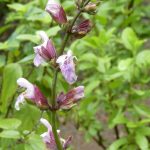Salvia officinalis ‘Rosea’: is a low bushy subshrub, 30 – 40cmH with stems of pale pink flowers in spring, continuing through to late summer.

Salvia ‘Rosea’: is a pink form of the edible Stuffing Sage.
Flowers: are a pale pink falcate type. The hood and 2 side lobes being a delicate white to shell pink. The 2 side lobes are fanned out to allow bees and insects entry into the flower. The large bottom lobe has lovely pink markings on the lobe and around the throat area; acting as beeline to attract insects to crawl further into the flower.
Flowers are held in small whorls of 4 flowers, 2 on each side of a green stem. Numerous stems of pink flowers are sent up, all with small side shoots with yet more flowers. These are held above the foliage to attract passing pollinating insects.
Calyces: are crimson which show off the pale pink flowers beautifully. Lobes are wide, ribbed and slightly pointed. These remain on the stem well after the flower has finished, needing to be cut off at the end of the season. Hopefully containing 4 little black seeds.
Leaves: are a typical Sage leaf, long, lanceolate, grey green in colour, a thin texture with a rugose surface, to channel any moisture down to the roots. These are edible, with a soft sagey smell used for cooking or as a tea.
Salvia ‘Rosea’: is a form of Stuffing Sage with pretty pink flowers.
Plant in a full sun position either in an open area or in a mixed border with other perennials and small shrubs. This Salvia makes a spectacular show when in full flower, especially if planted along an edge to a path or edging a bed next to a lawn. Watch the bees and small butterflies perch on the flowers on a sunny day.
This is a tough hardy plant for the hot dry summer season. It is usually frost and cold hardy, but does appreciate snail pellets or other treatments when there is a lot of moisture.
Best grown on well drained soils as it can rot with too much moisture. Downy mildew can appear on leaves in wet conditions, especially if shaded too much from other plants.
In late winter /spring, feed and mulch well to keep the root area cool during the hot dry summer season.
In early summer, begin trimming the plant, cut off any flowering stems, cut the leaf stems down by half ( keep these for cooking) to encourage new growth and flowers. But in late summer/ early autumn, when most of the flowers have finished, begin cutting off the spent flower stems, collecting any seed. Clean up old leaves, cut down any dead or weak stems and any general debris, top up mulch.
Propagation: is usually by side shoots or tip cuttings from new shoots during the season, seeds can be sown in early spring.


